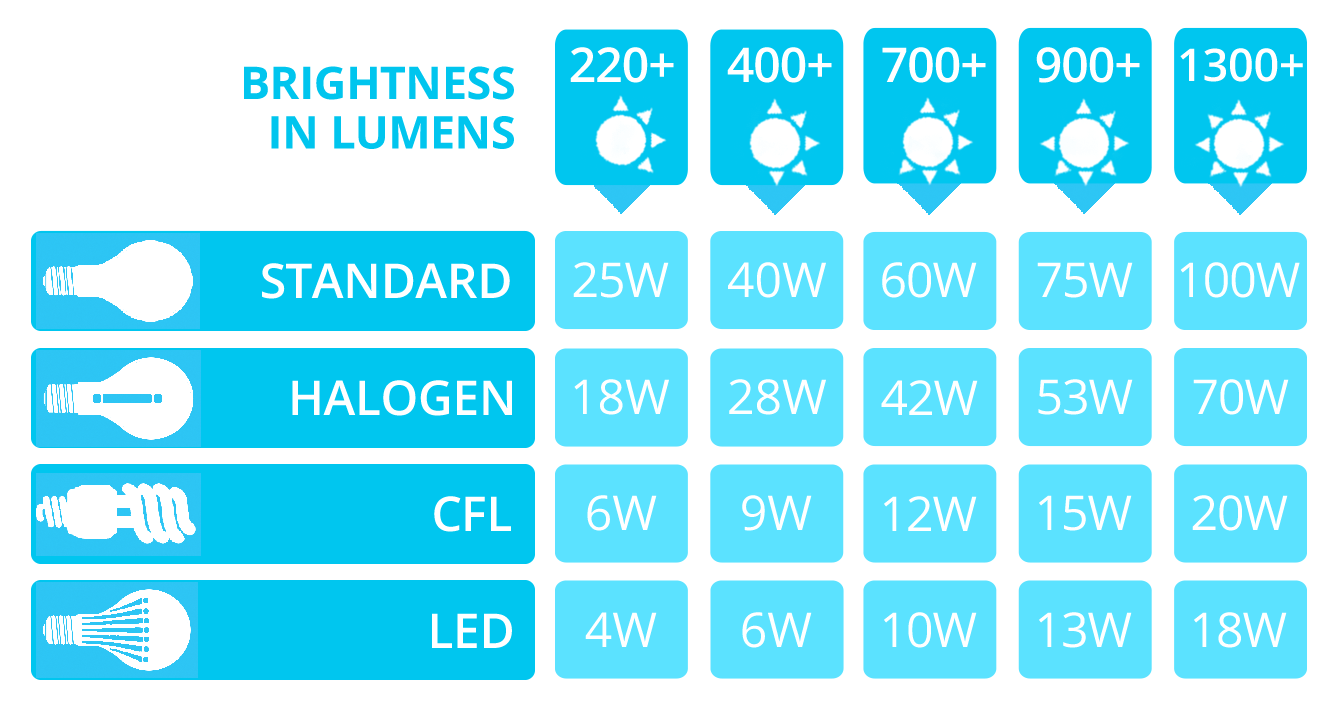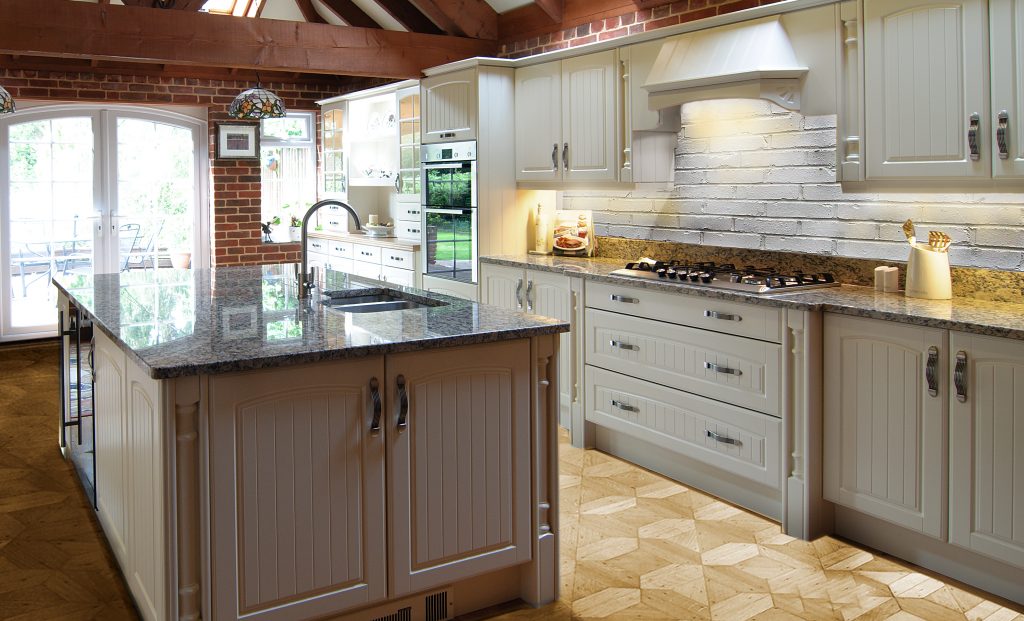Under cabinet lighting is an important, yet often overlooked part of your kitchen. While it’s not as glamorous or fun as picking out cabinet colors, countertop material or backsplash tile, under cabinet lights add warmth and draw the eye to important details. Who can see your neat tile backsplash if there are shadows under the cabinets? How can you read your cookbook while baking a late night dessert if your overhead lighting is eight feet above you?
Why do you need under cabinet lighting?
As any lighting expert would say, your room needs “layers” of lighting. First is ambient lighting, which is your overhead lights – think can lights or ceiling fixtures. Next is task lighting. Much like a desk lamp helps you read while working, under cabinet lighting provides you directed light for completing tasks in the kitchen. Reading a cookbook, measuring, rolling out dough, or decorating cupcakes are all made easier by having directed light on your project.
With proper light, you should be able to distinguish the ingredients you throw into a bowl quite easily. Telling the difference from baking powder and flour may not be easy in a dimly light kitchen, but should be a piece of cake with proper task lighting.
Depending on their placement and direction, under cabinet lighting can also draw the eye to backsplash details as well as provide a soft, moody light at night.
Plugin vs Hardwired vs Battery Under Cabinet Lighting
Plugin lights are great for the do-it-yourselfer. They’re quick to install and still provide the task lighting you need. However it sucks to have to plug in each under cabinet light individually, in addition to having the ugly cord hanging down. Plug in undercabinet lights are great for renters, since you can just remove them and take them with you if moving. It’s also less expensive, since you don’t need an electrician.
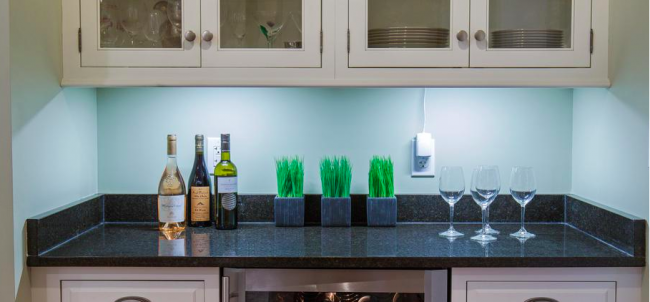
Battery operated under cabinet lights are another great option for renters. Usually mounted with command tape, battery operated lights usually have a small switch to turn them on. If you have a small kitchen or open shelving, battery lights might also work for you. There’s no point in spending a ton of money to install lighting on the underside of one cabinet, just use a simple battery light when you need the task lighting.
Hardwire lights are operated by a light switch. This is handy because it lights up all the kitchen surfaces at once instead of needing to individually plug in each light. Another great trait of hardwire lights is dimmability. LED lights (which we will get in to later) can be too bright for many people and the ability to dim them is necessary. Additionally, most hardwire lights are now energy efficient and though you will be adding to your electricity bill, you won’t be spending much on batteries.
Types of Light Bulbs
LED Under Cabinet Lighting
LED lighting is a newer technology and is quickly overtaking other forms of light bulbs because of its energy savings, low heat output, and long life. LED light bulbs are cool to the touch and should last about 6 years. They are 90% more efficient than traditional incandescent bulbs.
LED stands for light emitting diodes. The diode produces light, unlike other lights which use heat to emit light. LED comes in a wide variety of colors and brightness. If you choose LED, be sure to get a dimmer installed with the lights. LED lights are very bright and it is always recommended that you have the option to dim them.
The downside of LED under cabinet lighting is that the upfront investment may be significant compared to other lights. However this cost should be offset by the long life of the bulb.
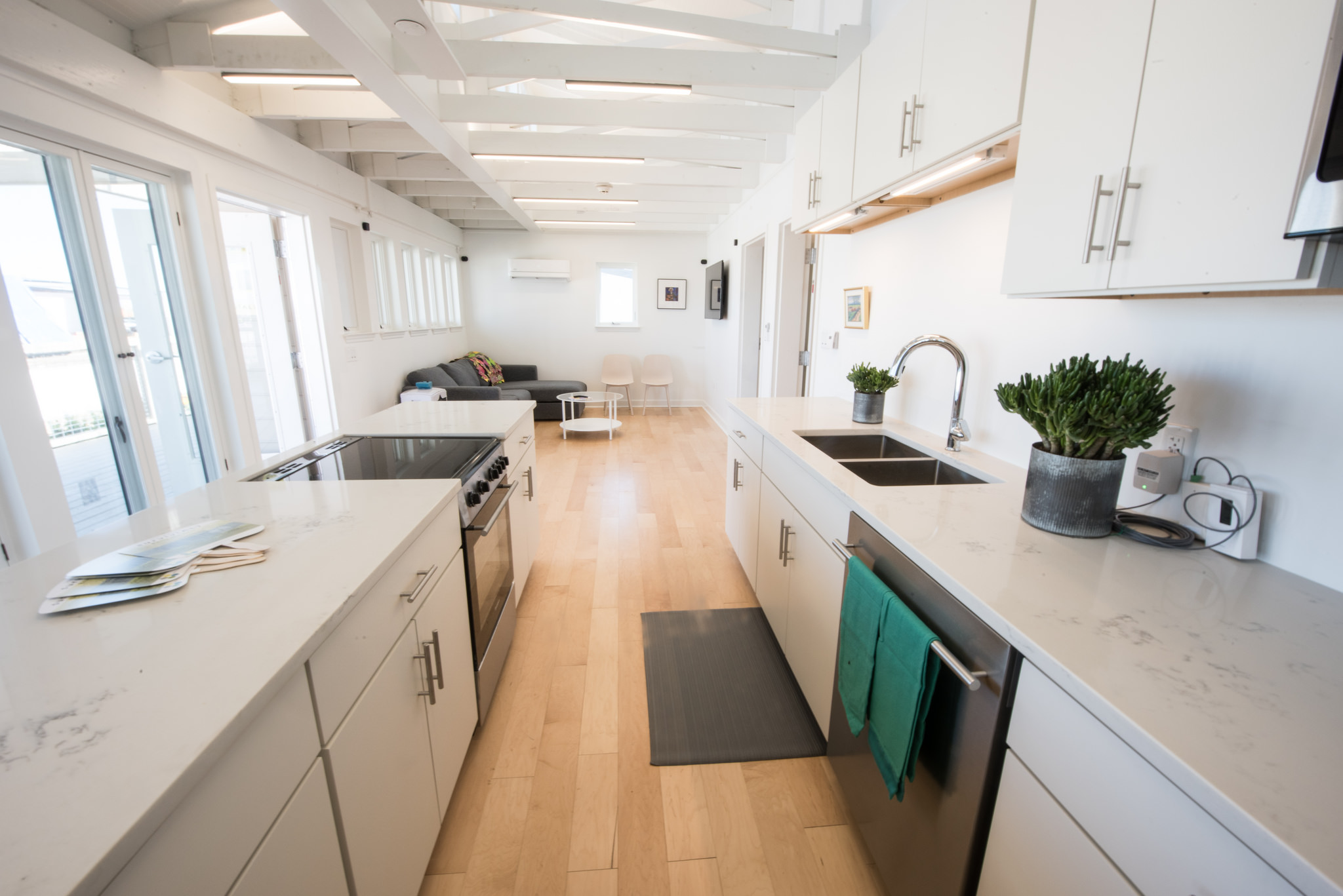
Fluorescent Under Cabinet Lighting
Today’s fluorescent lights are nothing like the original greenish and loud lights of the past. Current bulbs should not hum or flicker or take a significant amount of time to illuminate after you flip the switch. Fluorescent lights are cheaper than LEDs and since they’re been around longer, they come in a variety of options. Though LED lights are considered more energy efficient, fluorescent bulbs are still more efficient than incandescent and are considerably cool to the touch.
A fluorescent bulb products light by heating tungsten coils at both ends of the narrow tube. This passes electrons back and forth, which emit UV light when they collide with mercury atoms in the tube. This produces the light we see when it passes through the phosphor coating on the inside of the tube. A downside to using this option- if a bulb were to break when handling it, mercury is hazardous to your health.
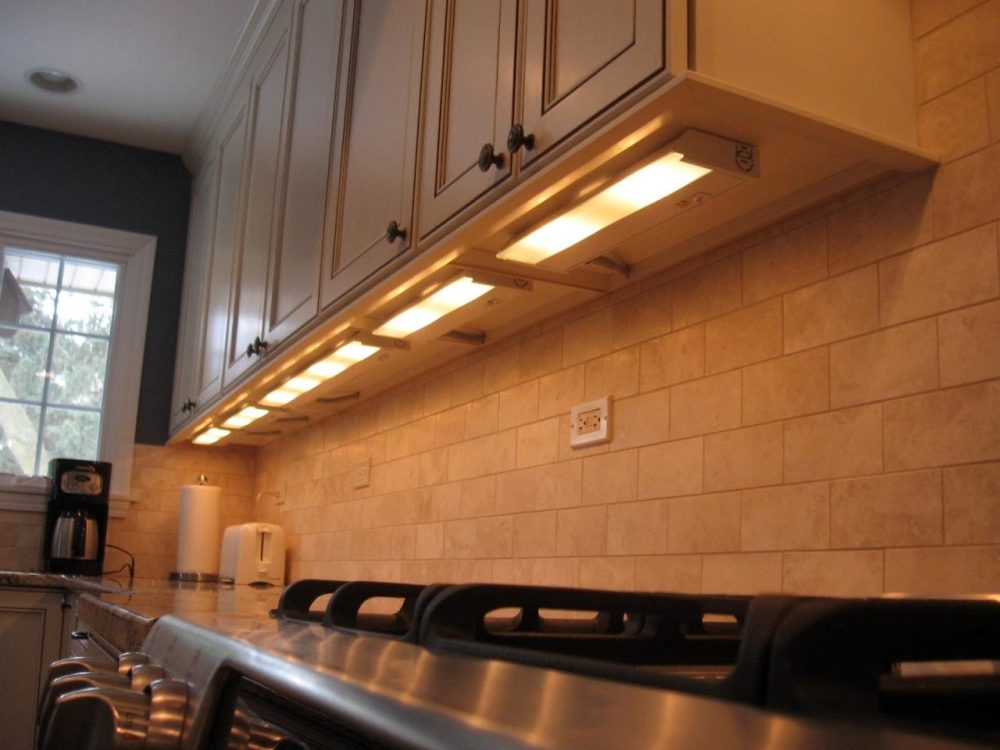
Slim fluorescent housings are a great option for under cabinet lighting. Half inch tubes are labeled T4 and are easy to find online or at any hardware store. It’s not recommended that you choose a bulb that is an inch in diameter or bigger because it cannot be hidden under the cabinet.
The wattage denotes the brightness of fluorescent lights, so compare bulbs before buying. The majority of fluorescent lights cannot be dimmed, so picking a wattage that is the correct brightness is important.
Xenon Under Cabinet Lighting
Xenon lights are a type of incandescent bulb (light is produced by heating wire filament) that also have xenon gas added to the bulb. This gas slows down the decomposition process of the wire filament, so that it lasts longer.
Xenon bulbs are also cooler than halogen and incandescent bulbs, which makes them more energy efficient. This lighting type also renders colors perfectly and is dimmable. People prefer them when they want the warmer color lighting. Xenon is less energy efficient than LED and fluorescent.
Halogen / Incandescent Under Cabinet Lighting
Similar to xenon, these light bulb types produce light by heating a wire filament. These bulbs also run the hottest, which is why it isn’t usually recommended to use these as under cabinet lighting. The heat may spoil produce sitting under the cabinet or food inside the cabinet above the lighting. The heat may also make you uncomfortable working under them.
Housings for these light bulb types do exist, though it’s not recommended to use them.
Types of Under Cabinet Lights
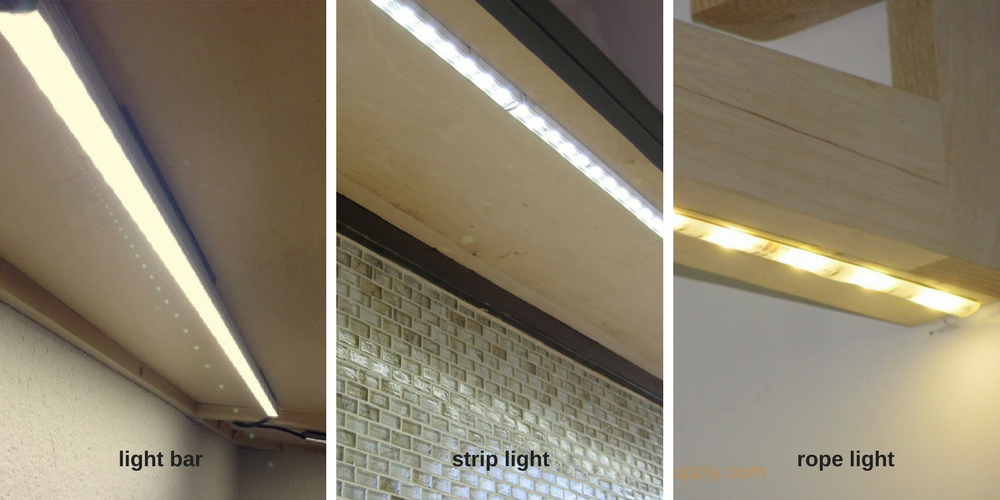
Strip or Tape Under Cabinet Lights
Interchangeably used, strip lighting or tape lighting is a flexible strip with small LED diodes attached to it. It comes in several lengths and can be cut to size. It’s easily applied with an adhesive backing and has a thin profile that makes it easy to hide under cabinets.
If you have a large kitchen, the cost may add up, so price it out beforehand along with the cost of the electrician. Additionally, LED is very bright so be sure that you like the color before installing since it can’t be changed (unless you remove it). There have been complaints about a “landing strip” effect with shiny surfaces.
Rope Under Cabinet Lights
Ropes lights have been on the market for a long time. The bulbs are housed inside a flexible clear casing made of plastic. Rope lights provide a 360 degree angle light and are dimmer than strip or tape lights, making them great for decorative or accent lighting. They are easy to tuck away under a cabinet, making them disappear.
Before LEDs became affordable, halogen lights were used though now they can be found with LEDs as well at good prices. LED and halogen rope lights come in long lengths and can be customized to any kitchen. They’re quite affordable and easy for an electrician to install.
Light Bar Under Cabinet Lights
Bar lights are a linear plastic housing that can come in fluorescent or LED form. Most of the older types of under cabinet lighting are fluorescent light bars. They are low profile and easy to install. Additionally, light bars provide a uniform brightness under the cabinets and are great for illuminating tasks on the countertop.
Light bars for under cabinet lighting also come in both hardwired, battery and plugin form.
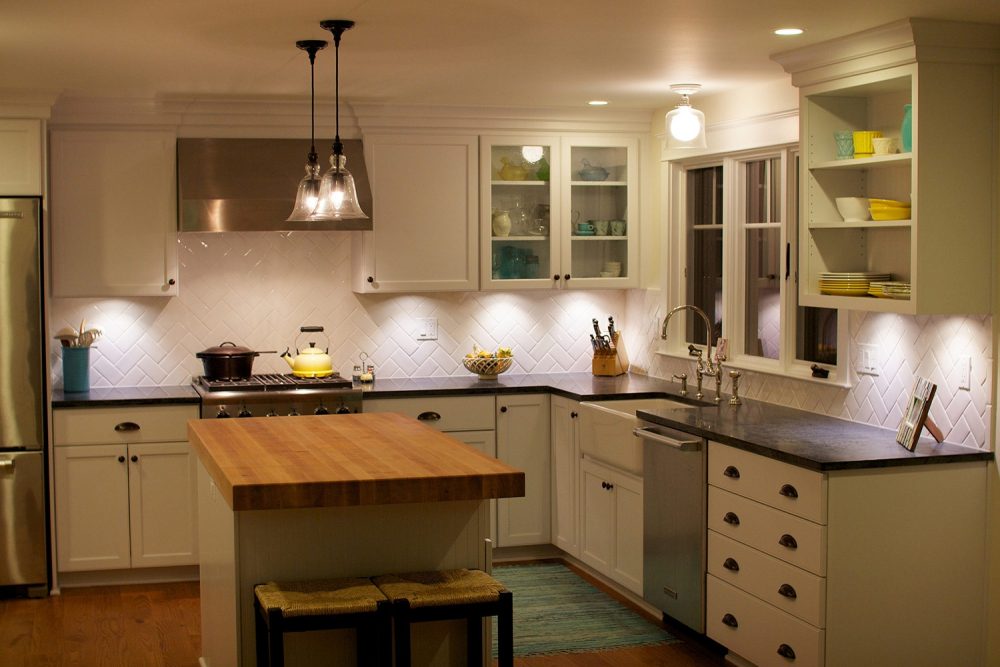
Puck Under Cabinet Lights
Puck lighting requires a bit more planning, though they are still as good as an option as any other under cabinet lighting. Puck lights are a single round housing and should be placed 8-12 inches apart, depending on the effect you want. Light pucks placed further apart will give a spotlight look, illuminating the backsplash and counter. Pucks placed closer together will give a more seamless lighting look, with less shadow on the backsplash.
Some light pucks may be recessed in to the cabinet, so be sure to read up before you choose. Others may be screwed or mounted with adhesive directly to the bottom of the cabinet. Light pucks come in a variety of profile heights, so examine the trim height on your cabinet so that the light housing does not extend below. Most battery powered under cabinet lighting comes in puck form.
Puck lights come in several light bulb types: incandescent, CFL (compact fluorescent) and LED.
All other lights provide a uniform look when it comes to task lighting.
Where to Place Under Cabinet Lights
Most references recommend placing the lights at the front of the cabinet. The trim in the front hides it well and the downlight illuminates the spot where your hands will be working. While it might be easier for electricians to install the light further back, the forefront of the cabinet is the way to go.
A light installed at the forefront of the cabinet will also reduce glare and minimize the light being seen from people being seated across the room.
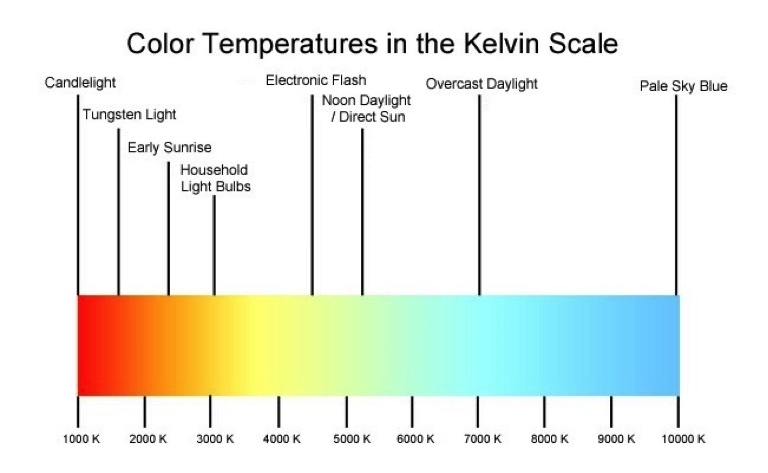
Under Cabinet Light Color
Finally, choosing the color is another (yes another!) important step of the process. Light have different colors ranging from a cool blue tone to a warm yellow. The color temperature of the bulb has a big impact on how your kitchen looks and feels. Temperature is measured in a Kelvin scale from 2700 to 7000.
Bluer bulbs are best for kitchens with cool tones, like white. It makes the whites look even more crisp. However if you go too blue, you risk making your kitchen feel like a doctors office. A bulb temperature of 3,500-4,100 will do.
Warm toned kitchens with wood cabinets and a warm backsplash are better off with warmer toned bulbs. Aim for a bulb temperature of 2,700-3,000.
If you want your under cabinet lighting to provide a warm feeling ambiance, a warm bulb is the way to go, despite the color of your kitchen. If you need great task lighting for your cake decorating or to help aging eyes, a cool bulb is what you need.
Lumens
Lumens is a measure of the light output. This is especially important when choosing an LED bulb since they can be very bright. The last thing you want is to choose something that hurts your eyes when working in your kitchen and glare from super bright lights could do it. On the other hand, lights that aren’t bright enough are just wasted effort, thus the importance of finding the balance between the two.
Take a look at the chart below to figure out how bright you want your kitchen task lighting to be.
